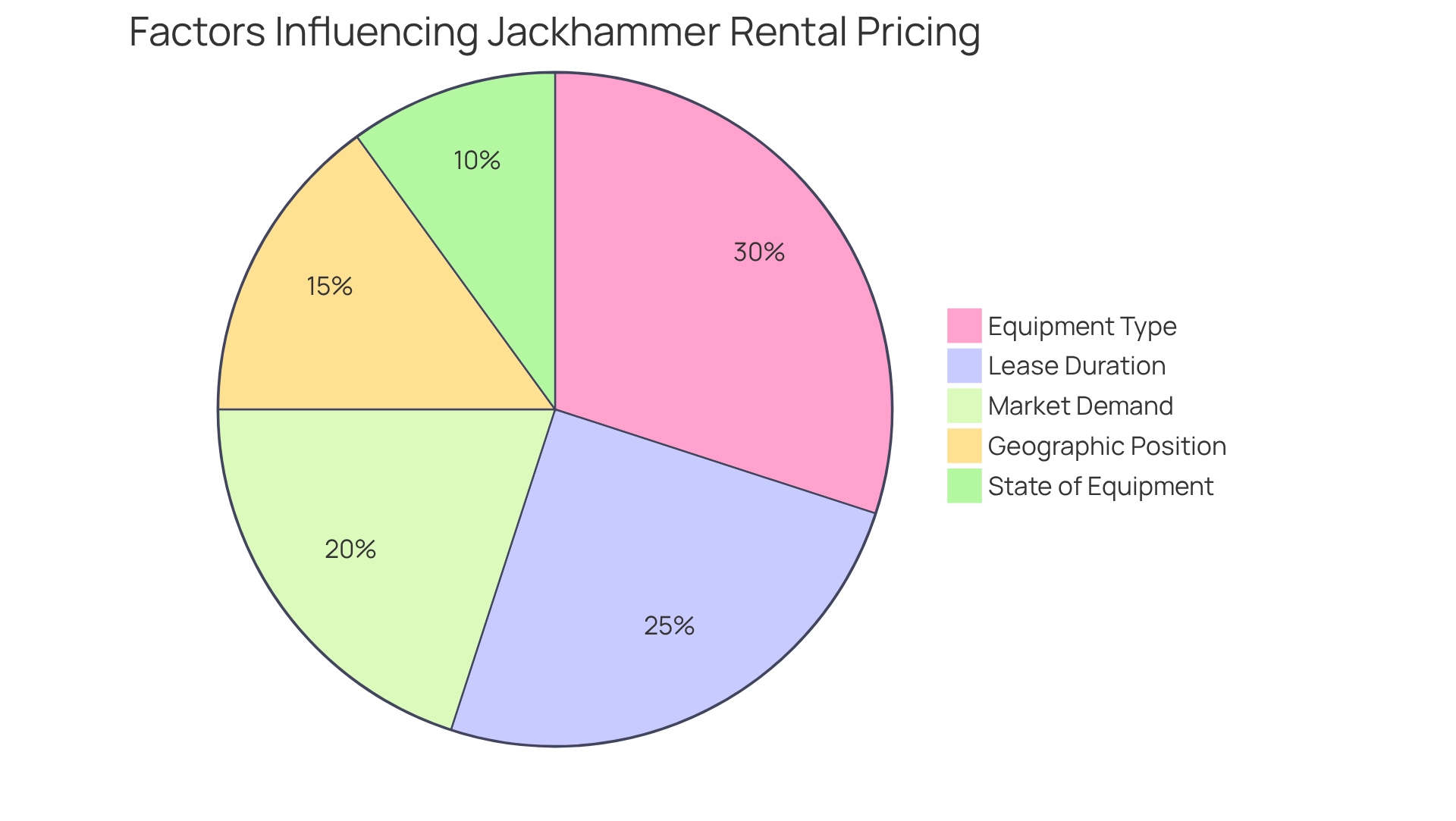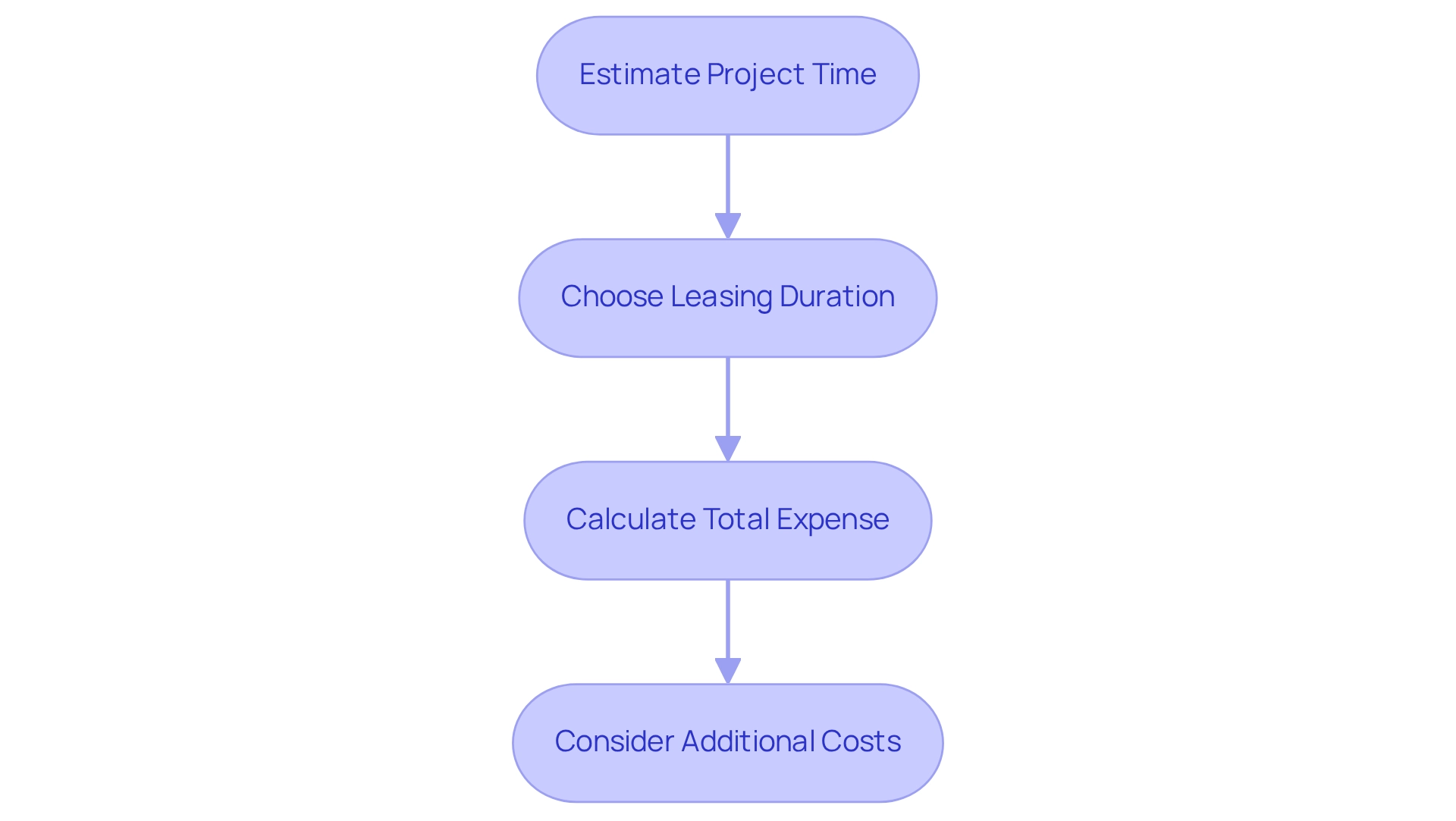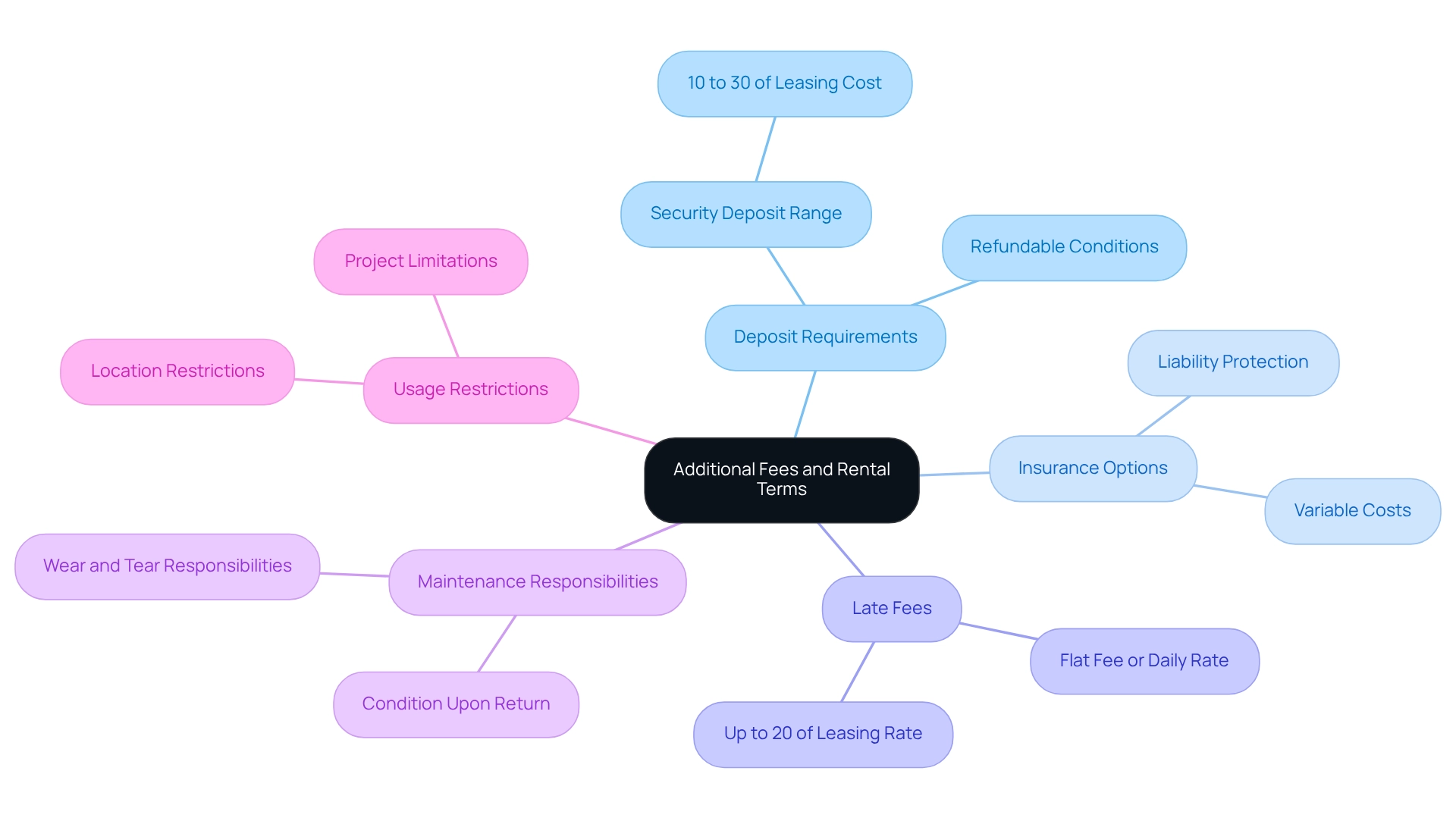Overview
The article outlines four essential steps to effectively determine how much to rent a jackhammer, focusing on critical factors such as:
- Equipment type
- Lease duration
- Market demand
- Additional costs
By analyzing these elements, the article provides a systematic approach to calculating rental expenses. This guidance empowers readers to make informed decisions that align with their project needs and budget constraints. In addition, understanding these factors not only simplifies the rental process but also ensures that you select the right equipment for your specific requirements.
Key Highlights:
- Rental prices for jackhammers vary based on equipment type, with heavier models costing more.
- Lease duration affects pricing; longer leases typically reduce daily costs.
- Market demand influences rental rates, increasing during peak construction seasons.
- Geographic location impacts leasing costs, with urban areas generally having higher prices.
- The condition of the equipment affects rental prices, with newer models commanding higher fees.
- To calculate rental costs, estimate project time, choose a leasing duration, and multiply the daily rate by the number of days.
- Additional expenses like delivery fees and insurance should be included in the total rental cost.
- Research local providers and obtain quotes to compare rental options effectively.
- Review leasing agreements for hidden fees and terms, such as late return charges and maintenance responsibilities.
- Understand deposit requirements, insurance options, and usage restrictions before finalizing a lease.
Introduction
Navigating the world of equipment rentals presents a significant challenge, particularly when selecting the appropriate jackhammer for your project. Various factors influence rental prices, including:
- Equipment type
- Rental duration
- Market demand
- Geographic location
Understanding these intricacies is essential for effective budgeting. Furthermore, calculating rental costs necessitates careful consideration of project timelines and potential additional fees. By comparing rental options and thoroughly reviewing terms, individuals can make informed decisions that align with their project needs.
This article delves into the critical elements of jackhammer rentals, providing insights and strategies to optimize costs and enhance project efficiency.
Understand Rental Pricing Factors
Several key factors significantly influence how much to rent a jackhammer.
- Equipment Type: The leasing prices fluctuate considerably across various models and sizes of breaking tools. Typically, how much to rent a jackhammer varies, as heavier and more powerful models demand higher fees compared to lighter ones, reflecting their enhanced capabilities. Furthermore, package offers for large-scale machines generally lead to reduced leasing rates compared to acquiring each item separately, which can be a budget-friendly approach for managers overseeing tasks.
- Lease Duration: Generally, leasing costs diminish with extended lease periods. Daily rates are frequently more expensive than weekly or monthly rates, making it crucial to understand how much to rent a jackhammer in relation to your duration and timeline to enhance expenses. Proactive planning, such as consolidating leasing needs and securing equipment beforehand, can lead to better rates and enhanced timelines, as emphasized in the case study titled "Plan Ahead."
- Market Demand: Rental prices can fluctuate based on local demand. During peak construction periods, such as spring and summer, leasing costs may rise due to increased demand for equipment. Comprehending market demand is essential, and adaptable leasing conditions, such as those provided by Louisiana Rents, can support various lease durations, allowing customers to consider how much to rent a jackhammer based on their project requirements.
- Geographic Position: Geographic position plays a crucial role in pricing for leases. Urban areas often experience higher leasing rates compared to rural locations, influenced by factors such as competition and operational costs.
- State of Equipment: The state of the tool also impacts leasing costs. When considering how much to rent a jackhammer, it's important to note that newer or well-maintained equipment usually incurs higher charges, as they are viewed to provide better reliability and performance compared to older, less dependable models.
Including these elements in your financial planning and budgeting procedures is crucial for choosing the appropriate tool for your requirements. As Sophie Liu aptly puts it, "Let's make things better together!" This joint method for planning leases can greatly improve results.

Calculate Rental Duration and Costs
To effectively calculate the rental duration and costs for a jackhammer, follow these essential steps:
- Estimate Project Time: Begin by assessing the duration needed for the equipment based on your specific project requirements. Key considerations include the size of the area to be worked on and the type of material being broken. For instance, a larger area with reinforced concrete will require more time than a smaller, less dense surface.
- Choose Leasing Duration: Next, decide on the leasing duration—whether for a few hours, a day, or longer. Rental companies typically offer various pricing tiers based on the duration, which can help customers determine how much to rent a jackhammer, allowing for flexibility in budgeting.
- To calculate the total expense of how much to rent a jackhammer, multiply the daily rental rate by the number of days you plan to rent it. For example, if the daily rate is $100 and you require it for 3 days, your total expense would be $300. This straightforward calculation aids in aligning expenses with project budgets.
- Consider Additional Costs: Finally, don’t forget to factor in any extra expenses that may arise, such as delivery fees, insurance, or damage waivers. These can significantly influence the overall leasing expense, making it vital to incorporate them into your financial planning. As highlighted in a case study on trencher leases, additional expenses can accumulate quickly, impacting the overall budget.
By following these steps, you can precisely calculate how much to rent a jackhammer, ensuring it fits within your budget and schedules. As Cesar Pelli aptly stated, "Construction is a matter of optimism; it’s a matter of facing the future with confidence." This methodical approach not only aids in financial planning but also enhances project efficiency, allowing for smoother operations on-site.

Compare Rental Options and Prices
To effectively compare rental options and prices for jackhammers, follow these essential steps:
- Research Local Equipment Providers: Start by identifying equipment leasing companies in your area, including EZ Equipment Rental, which offers a diverse range of machinery such as boom lifts, excavators, and forklifts. Browse their website for available demolition tools and pricing information to understand your options better.
- Request Quotes: Reach out to multiple leasing firms to obtain quotes for the same model of jackhammer. Be specific about the leasing duration to understand how much to rent a jackhammer, as this can significantly impact your overall cost.
- Evaluate Terms and Conditions: Carefully review the leasing agreements. Pay attention to potential hidden fees, such as late return charges or maintenance costs, which could affect the total leasing expense. Remember, contractors may double the price for concrete thicker than 6 inches, so choosing the appropriate tool is crucial for your project's budget.
- Check Equipment Availability: Confirm that the desired jackhammer is accessible for your intended usage period. Availability may vary, particularly during peak seasons, making it vital to plan ahead.
- Read Reviews: Investigate customer feedback and ratings for each leasing company. This feedback can offer valuable insights into their reliability and the condition of their equipment, helping you make an informed decision.
- Consider Expert Recommendations: Seek advice and product recommendations from experienced professionals in the industry. Their insights can guide you in making informed decisions that align with your project needs.
- Acknowledge the Industry's Value: As Stéphane Hénon, managing director of Loxam, states, "Celebrate yourselves, celebrate your people and celebrate your industry, whether you’re a big company or a small company." Acknowledging the contributions of leasing companies like EZ Equipment Rental can enhance your understanding of their significance in the construction sector.
By methodically assessing these elements, you can determine how much to rent a jackhammer that fits your budget and specifications. Furthermore, consider the broader impact of your decisions, as illustrated in the case study 'Celebrating the Leasing Sector,' which underscores the importance of the leasing sector in aiding construction projects.
Review Additional Fees and Rental Terms
Before finalizing your equipment lease, it is crucial to examine the following additional charges and terms of use:
Deposit Requirements: Most leasing companies necessitate a security deposit, typically refundable upon the return of the equipment in good condition. Understanding how much to rent a jackhammer, along with the usual security deposit, will aid you in budgeting effectively. Industry standards indicate that security deposits can range from 10% to 30% of the leasing cost, depending on the equipment and leasing company.
Insurance Options: Inquire whether the company provides insurance for the equipment. This coverage can protect you from liability in case of damage or accidents, offering peace of mind throughout your project. The costs associated with insurance for equipment usage can vary, so it is advisable to ask about specific rates.
Late Fees: Familiarize yourself with the penalties for late returns. Many businesses impose either a flat fee or a daily rate for each day the equipment is overdue, which can significantly increase your usage costs if not managed properly. For instance, some companies may charge a daily late fee that can reach up to 20% of the leasing rate.
Maintenance Responsibilities: Clarify who bears the responsibility for maintenance during the rental period. Some companies may require you to return the tool in the same condition it was rented, including addressing any wear and tear incurred during use. Understanding these responsibilities can help you avoid unexpected charges.
Usage Restrictions: Review any limitations on how the demolition hammer can be utilized. Certain companies may restrict its use for specific types of projects or in designated locations, potentially impacting your project planning. For example, knowing how much to rent a jackhammer for use in residential areas may face additional restrictions due to noise regulations. By thoroughly reviewing these conditions, you can prevent unforeseen fees and ensure a seamless leasing experience. Additionally, it is vital to be aware of your rights and responsibilities concerning security deposits and late fees, as outlined in local rental laws. This knowledge empowers you to negotiate better terms and avoid potential pitfalls.

Conclusion
Navigating the complexities of jackhammer rentals is essential for ensuring project success while adhering to budget constraints. Understanding key factors such as equipment type, rental duration, market demand, and geographic location is crucial, as they all significantly influence rental costs. By grasping these elements, individuals can make informed decisions that optimize expenses and enhance overall project efficiency.
Calculating rental duration and costs necessitates a methodical approach. Estimating project time and considering additional expenses are critical steps in aligning rental costs with project budgets. Furthermore, comparing rental options and carefully reviewing terms can unveil hidden fees and help secure the best deal available. This diligence not only saves money but also ensures that the right equipment is available when needed.
Ultimately, the goal is to streamline the rental process and mitigate unexpected costs. By prioritizing thorough research and planning, individuals can select the right jackhammer and rental terms that best fit their project needs. Embracing this proactive mindset fosters a smoother rental experience and lays the groundwork for successful project execution.
Frequently Asked Questions
What factors influence the rental price of a jackhammer?
Several key factors influence jackhammer rental prices, including equipment type, lease duration, market demand, geographic position, and the state of the equipment.
How does the type of jackhammer affect rental costs?
Rental prices vary significantly across different models and sizes of jackhammers. Heavier and more powerful models typically incur higher fees compared to lighter models, reflecting their enhanced capabilities. Package offers for large-scale machines can also lead to reduced rates.
How does the duration of the lease impact rental costs?
Generally, leasing costs decrease with longer lease periods. Daily rates are often more expensive than weekly or monthly rates, so understanding the duration of the lease can help enhance expenses.
How does market demand affect jackhammer rental prices?
Rental prices can fluctuate based on local demand, particularly during peak construction periods like spring and summer when demand increases, potentially raising leasing costs.
Does geographic position influence jackhammer rental rates?
Yes, geographic position plays a significant role in pricing. Urban areas usually have higher leasing rates compared to rural locations due to factors like competition and operational costs.
How does the state of the equipment affect rental prices?
The condition of the jackhammer impacts rental costs; newer or well-maintained equipment typically incurs higher charges, as they are considered more reliable and perform better than older models.




